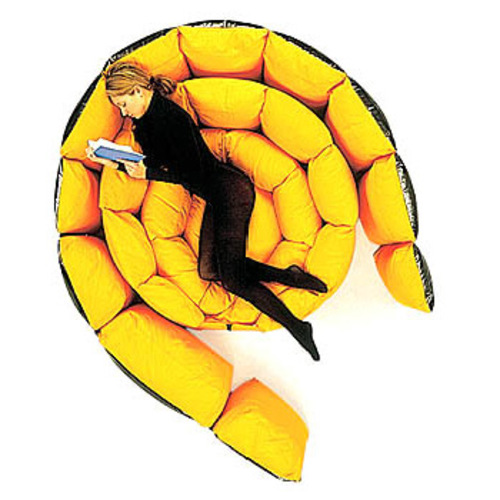
"I love sleep. My life has the tendency to fall apart when I'm awake, you know?"
-- Ernest Hemingway
We spend 1/3 of our lives asleep, and that is nothing to be ashamed of. It means that sleep, the night, beds and the like are all things we should enjoy exploring and relish knowing.

via SUPERTOUCHAt the Brooklyn Museum the Australian artist Ron Mueck has delivered “A Girl,” the biggest human infant ever hatched. More than 16 feet long (weight unrecorded) and not yet unhooked from her hawser-like umbilical cord, she still has traces of birth blood on her wrinkled body.
You may have sensed by now that she is not a real baby. What she is is an extraordinarily lifelike sculpture made with exquisite craftsmanship by the 48-year-old Mr. Mueck, who is known for his ultrarealistic re-creations of the human figure in silicone and fiberglass.
Forget the old adage early to bed, early to rise makes a man healthy, wealthy and wise. It is more likely to make him stressed. Not only that, getting up early is also more likely to lead to muscle aches, cold symptoms, headaches and significantly worse moods. |
Studies have demonstrated that caffeine disrupts sleep. When caffeine is consumed immediately before bedtime or continuously throughout the day, sleep onset may be delayed, total sleep time reduced, normal stages of sleep altered, and the quality of sleep decreased. Caffeine’s effects on sleep appear to be determined by a variety of factors including dose, the time between caffeine ingestion and attempted sleep, and individual differences in sensitivity and/or tolerance to caffeine. Caffeine-induced sleep disturbance is greatest among individuals who are not regular caffeine users. Although there is evidence for some tolerance to the sleep disrupting effects of caffeine, complete tolerance may not occur and thus habitual caffeine consumers are still vulnerable to caffeine-induced sleep problems. |

And this shot from My Dragonfly of sleepy sibling sweetness holds the magic of togetherness that every parent dreams of. Heavy sigh. What a captivating moment and an absolute perfect image! I could stare at it for days.


 presents the case after reviewing the possible effects caffeine laced beer could have on drinkers.
presents the case after reviewing the possible effects caffeine laced beer could have on drinkers.OBJECTIVES: This study examined the role of individual and combined sleep-related dysfunctional beliefs in late-life insomnia. METHODS: Older adults who responded to an advertisement in a magazine took part in a cross-sectional survey (N=382). Respondents completed self-report measures of dysfunctional beliefs about sleep (Dysfunctional Beliefs and Attitudes to Sleep Scale) as well as measures of their current sleep patterns. RESULTS: Overall, people with insomnia (PWI) endorsed more extreme ratings of dysfunctional beliefs than "good sleepers" did. However, some sleep-related dysfunctional beliefs did not discriminate PWIs from good sleepers nor were they related to experiencing a longer duration of insomnia. CONCLUSION: This article demonstrates that not all sleep-related dysfunctional beliefs are related to reporting insomnia and that some are not related to a longer reported duration of insomnia, possibly changing through personal experience. These preliminary results may have implications for tailoring the cognitive aspects of psychoeducational programmes for people with late-life insomnia.
|
Most of the nation will turn its clocks ahead at 2 a.m. Sunday, three weeks earlier than usual. In November, the fallback is a week later than last year.
The idea: Align daylight hours with the time that most people are awake and reduce the need for artificial light.
"That was theory," Downing said. "It didn't work."
Human behavior gets in the way, he said. When the sun sets later, people do more outside the home. That usually means they get in the car and burn more gasoline, using as much energy in the long run as they would have if darkness had fallen earlier, said Downing, a Tufts University lecturer whose book "Spring Forward: The Annual Madness of Daylight Saving Time" was published in 2005.
"It has always been a beloved target for baseball and the golf and retail industries," he said. "People shop more after work if there are extra daylight hours."

The Foetus: Those who curl up in the foetus position are described as tough on the outside but sensitive at heart. They may be shy when they first meet somebody, but soon relax. This is the most common sleeping position, adopted by 41% of the 1,000 people who took part in the survey. More than twice as many women as men tend to adopt this position.
Log (15%): Lying on your side with both arms down by your side. These sleepers are easy going, social people who like being part of the in-crowd, and who are trusting of strangers. However, they may be gullible.
The yearner (13%): People who sleep on their side with both arms out in front are said to have an open nature, but can be suspicious, cynical. They are slow to make up their minds, but once they have taken a decision, they are unlikely ever to change it.
Soldier (8%): Lying on your back with both arms pinned to your sides. People who sleep in this position are generally quiet and reserved. They don't like a fuss, but set themselves and others high standards.
Freefall (7%): Lying on your front with your hands around the pillow, and your head turned to one side. Often gregarious and brash people, but can be nervy and thin-skinned underneath, and don't like criticism, or extreme situations.
Starfish (5%): Lying on your back with both arms up around the pillow. These sleepers make good friends because they are always ready to listen to others, and offer help when needed. They generally don't like to be the centre of attention.
|





"The whole Armor of God Pajama set will help your children to depend on God to protect them from their fears, doubts, and uncertainties at night so their sleep can be restful and peaceful."
